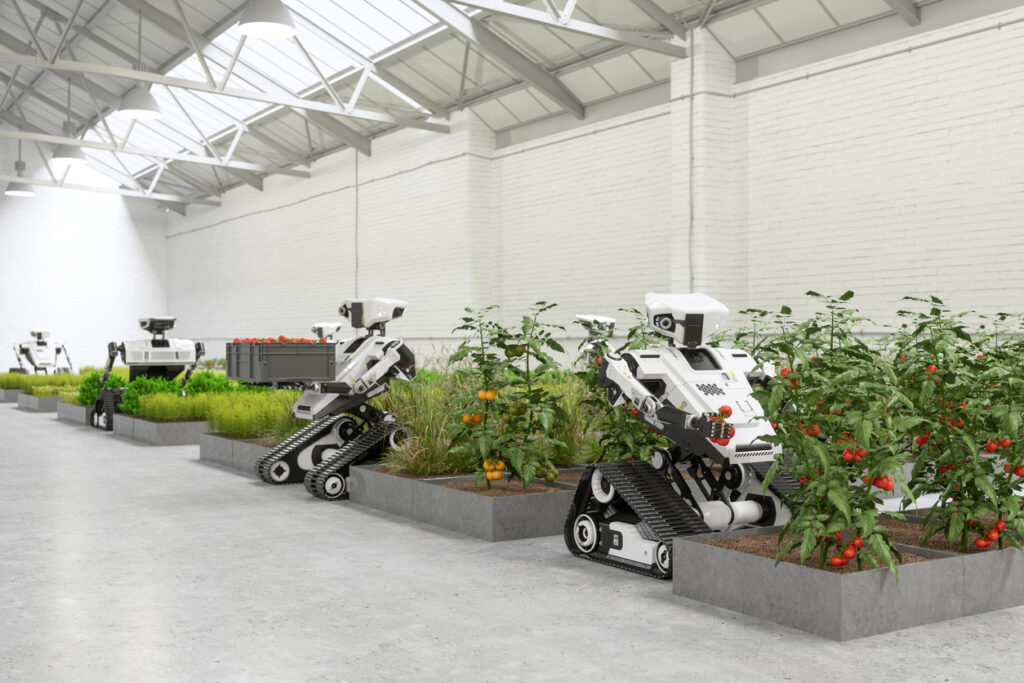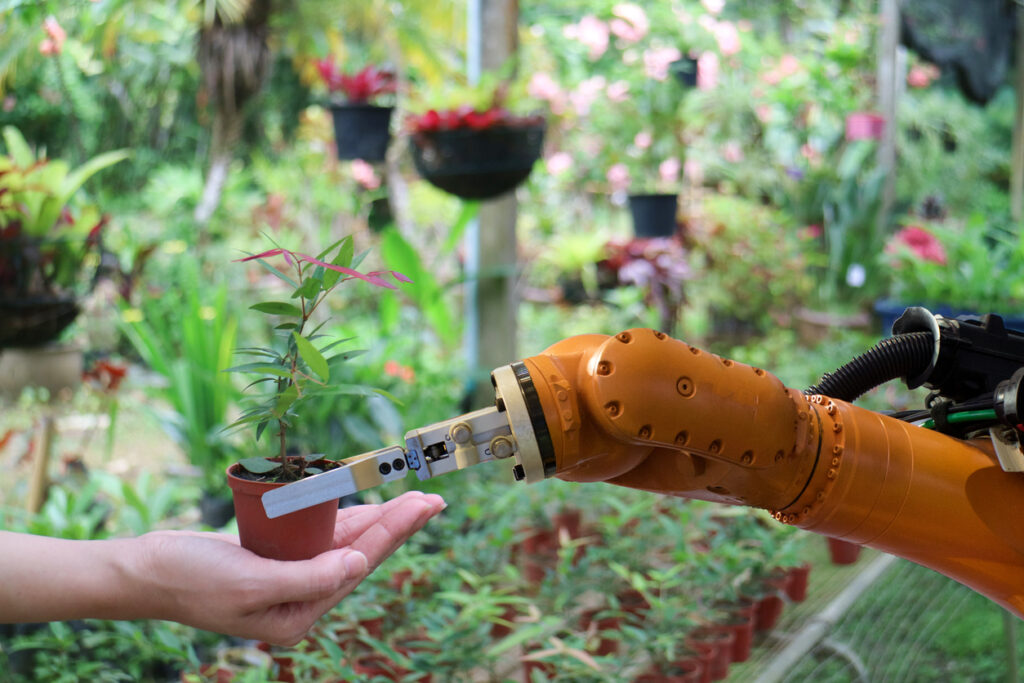Während automatisierte landwirtschaftliche Geräte technisch gesehen schon vor hundert Jahren entwickelt wurden, sind echte Landwirtschaftsroboter erst gegen Ende des 20. Jahrhunderts lebensfähig geworden. Es sind vor allem die erheblichen Fortschritte bei der Rechenleistung und der maschinellen Bildverarbeitung, die Roboter in der Landwirtschaft praktisch einsetzbar machen.
Agrarroboter ersetzen menschliche Arbeitskräfte bei repetitiven oder körperlich anstrengenden Arbeiten oder werden für nischenspezifische Aufgaben eingesetzt. Laut des Marktforschungsunternehmens BlueWeave Consulting wird der globale Markt für Agrarroboter in den kommenden Jahren ein enormes Wachstum verzeichnen. Bis zum Ende des Jahrzehnts wird ein Jahresumsatz von 81 Milliarden Dollar erwartet.
Lesen Sie mehr über die wachsende Beliebtheit von Landwirtschaftsrobotern in unserem E-Book zur Einführung in die Robotik.

Warum werden Roboter in der Landwirtschaft eingesetzt?
Ähnlich wie bei jeder anderen Industriemaschine lassen sich mit Agrarrobotern drastische betriebliche Verbesserungen erzielen. Folglich können Landwirte die Gesamteffizienz steigern und den Produktionsertrag ihrer Flächen erhöhen. Weitere Vorteile von Landwirtschaftsrobotern:
- Farm deployed robots make fewer errors and operate at higher speeds than human workers can.
- Agricultural robots that feature weed and pest detection sensors allow farmers to lower pesticide usage, which thereby has ecological benefits. These intelligent machines ensure that spraying only needs to be done on affected areas, which can make farms relatively chemical-free.
- Much like other industrial robots, agricultural robots can operate right around the clock, with only minimal maintenance being needed. This reduces the dependence on human labor and curbs the overall cost of food production.
- Some agricultural robots can be equipped with various kinds of end effectors to make them more versatile and enable them to perform multiple tasks. This means that the investment needed can be spread more widely.
- Overall farm automation is making supply chains more efficient, ensuring minimal food wastage and greater profitability. This has the potential to lead to lower prices for consumers.
Trotz all dieser Pluspunkte gibt es noch einige Probleme, die aus technologischer Sicht gelöst werden müssen, bevor Agrarroboter auf breiter Front eingesetzt werden können. Doch bevor wir zu den Herausforderungen kommen, schauen wir uns erst einmal die verschiedenen Anwendungsbereiche an.
Wo werden Agrarroboter eingesetzt?
Die Roboter können folgende wichtige landwirtschaftliche Tätigkeiten übernehmen:
- Crop Seeding – The traditional method of planting seeds by scattering them can be less than optimal, with crop yields being detrimentally affected. Instead, autonomous seeding (helped by geo-mapping) ensures that the seeds are dropped at exactly the correct places and depths.
For measuring the level of liquids and solids in both huge seed silos and tiny storage containers, capacitive proximity sensors can be helpful. The CA30 sensors from Carlo Gavazzi are made to detect dry grain accurately. The sensor delivers a steady and accurate indication of the yield per unit area. Knowing these yields makes it simple to precisely alter the application of fertilisers and herbicides.
- Horticulture – Agricultural robots are of value in horticultural work, for the cultivation and delivery of potted plants. Among the numerous solutions for this is the one from Dutch firm, WPS. It offers smart picking and placing capabilities through its intelligent robotic arm, which is equipped with multiple sensors.
- Irrigation and Fertilizing – Precise irrigation systems aided by automation can significantly reduce water wastage. Though still in the research phase, agricultural robots have shown promise in traversing rows of crops and accurately sprinkling fertilizer or water on them.
- Harvesting – Picking crops is a repetitive process that is well suited to robots. It means that agricultural operations do not have to deal with the difficulties of recruiting seasonal workers (which in many countries are proving increasingly hard to find). It must be noted, however, that picked produce will need to be handled carefully, so as to prevent damage (otherwise there will be increased wastage levels to factor in). One company that specializes in harvesting strawberries is Harvest CROO. Their robots are designed to scan and determine the ripeness of berries and then pluck them without causing them any harm. To make harvesting even easier, Carlo Gavazzi provides a full variety of parts, ranging from inductive proximity sensors to passive magnetic pick-up sensors (PA2PK).

- Weeding – Weed control is always a challenge, with plants developing pesticide resistance and heightened consumer demand for organic food where only minimal chemicals have been used. Fortunately, certain agricultural robots are resolving this problem. The Ted robot platform specifically caters to vineyards, and works by distinguishing between crops and weeds, before mechanically removing the latter. It is easy to operate and highly accurate. Most importantly, with help from this technology, farms can avoid any use of herbicides.
- Crop Health Monitoring – Sophisticated drones set up with camera sensors and featuring AI can identify diseases in crops. Through this, farmers are able to conduct early interventions. Equinox Drones represent an example of this. These offer access to real-time imagery for early disease assessment in crops. In case of crop damage, they also provide valuable information to help farmers take remedial measures in the future.
- Phenotyping – Phenotyping in agriculture is the process of measuring and understanding the characteristics of crops (such as resistance, growth, yield and adaptation). This procedure helps in improving their traits with respect to future plant breeding. Robotics in phenotyping is a relatively new field, but several robotics systems are showing their effectiveness in measuring chemical and physiological characteristics of various plants over time. A Belgian company WIWAM has a series of phenotyping robots that allow for non-invasive imaging of plants.
Welche Herausforderungen gibt es beim Einsatz von Landwirtschaftsrobotern?
Auch wenn die Nutzung von Agrarrobotern viele Vorteile bietet, gibt es auch einige Aspekte, die berücksichtigt werden müssen. So äusserten die Forscher der australischen Monash University Bedenken gegenüber den Einsatz von schweren Robotern in der Landwirtschaft, da diese zu einer Bodenverdichtung führen können. Sie befürchten auch, dass die Standardisierung der Produkte zu einer zunehmenden Abhängigkeit von gentechnisch veränderten Pflanzen führen könnte, die sich besser für die automatisierte Landwirtschaft eignen.
Da die Landwirtschaftsroboter bei Wind und Wetter verwendet werden, müssen die jeweiligen elektronischen Komponenten vor extremen Temperaturen und Feuchtigkeit geschützt sein, was sie teurer macht. Auch die für den Betrieb von Agrarrobotern erforderliche Automatisierungsinfrastruktur (z. B. drahtlose Verbindungen) kann für kleinere Betriebe unerschwinglich sein. Mit der Zeit wird der Kostenaspekt wahrscheinlich weniger problematisch sein, da die Preisgestaltung bei höheren Stückzahlen attraktiver wird.
Landwirtschaftsroboter sind auf dem Vormarsch und bieten nicht nur für die Landwirte und die von ihnen belieferten Verbraucher, sondern auch für die Umwelt, die Gesundheit und die Gesellschaft im Allgemeinen viele Vorteile.











